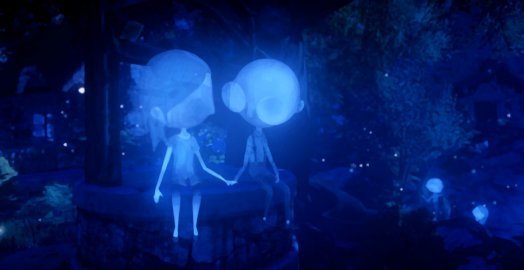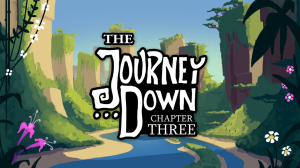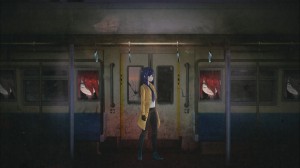Review for Last Day of June

Adventure games tend to be wordy beasts, what with their dialogue trees and dramatic plot twists packed into verbose cutscenes. Even a solitary experience like Myst gives you a library full of books to read. Adventures that lean more heavily on story than puzzles are often referred to as narrative games—a categorization that assumes the existence of narration, and therefore, of words. This love affair with words dates back to the earliest text parser games, and even a full 40 years after Colossal Cave Adventure, a completely mute adventure game can be a hard concept to embrace. How, exactly, can a game tell a good story without words?
Last Day of June is one such experiment, and considering this article surpassed 100 words before I even got around to naming the game I’m writing about, you might have an inkling of why I was apprehensive about reviewing it. I don’t like games that leave me grasping for meaning. Ambiguity is not my friend. And let’s be frank: I like words. Imagine my surprise, then, when the Last Day of June turned out to be if not the best adventure game I’ve played recently, then hands-down one of the best narrative games I’ve played, period.
In some ways, Last Day of June is like a Pixar movie on acid. Imagine that sweet couple from Up, but their heads are huge and their eyes are missing and when they speak to each other, all that comes out is a gibberish cadence of titters, chirps, giggles, and gasps. The art style is deliberately painterly, with swells of oversaturated color, bright sunlight, and overzealous impressionistic blur. The music—haunting instrumentals adapted from the compositions of progressive rock musician Steven Wilson—brings an aura of wonder and foreboding to this somewhat ordinary and yet perceptively off world. (Developer Ovosonico actually conjured up the world around Wilson’s music, with the game’s core premise paying homage to the song “Drive Home” and its accompanying music video.)
As the story opens, the comically bespectacled Carl and his wife, June, are spending a quiet afternoon by a lake. Exaggerated animations and vocalizations allow the characters to successfully pantomime what other games would take lines of dialogue to convey, so it’s immediately obvious from their body language, nuzzles, and kissy noises that these two are deeply in love.
When June shivers, Carl stands to retrieve her sweater. His short walk to the car provides a chance to familiarize yourself with the 3D controls: you walk using the gamepad’s left stick or WASD keys and move the camera with the right stick or mouse. As you approach an interactive item, such as the car door, the hotspot lights up and an on-screen prompt shows which button or key you need to press to interact.
Upon Carl’s return to the dock, June presents him with a gift. Before he can open the wrapped box, though, time jumps to an earlier point in the day back at home, with June as the playable character. This is the first of many time and control shifts in Last Day of June, a game in which June may be the focus but gets the least screen time due to the fact that she’s, well, dead.
Oops… spoiler alert? Not really, if you paid attention to the title. Last Day of June—which actually takes place in autumn, judging from the ripe apples in the trees and red leaves littering the paths—plays out during a repeated loop of the hours leading up to this date at the lake, as Carl tries to influence fate and prevent his wife’s untimely demise.
But let’s not get ahead of ourselves. As June tiptoes around her napping husband, looking for the perfect spot in their house to leave his wrapped gift, this early flashback initially struck me as a jarring and unnecessary interruption in the action. It turns out to be crucial to the storytelling. Pay attention to the characters you meet here: an old man who knocks on the front door, a little boy looking for a playmate, a man running around with his hunting rifle, a young woman awkwardly returning a can opener she borrowed. When you later gain access to a series of flashbacks shown from these characters’ perspectives, trying to pinpoint the one small change that might avert June’s fate, all of these seemingly inconsequential events become critically relevant.
First, though, the inevitable: back at the lake, Carl’s opening of his present is interrupted by thunder and lightning. As rain begins to pour, he and June run to the car. Carl gets behind the wheel. June slips into the passenger seat. They begin their drive home.
Then Carl awakens in his living room, alone.
At this point we don’t know exactly what happened to June—and we don’t need to. You’ll spend the rest of the game working out the details. For now, lighting, music, and animation deftly convey Carl’s loss. Except for a lit fire, the living room is dark. June’s easy chair is empty; a wheelchair sits beside Carl’s. The rooms of the house, bright and colorful when we first saw them in June’s flashback, have taken on a melancholy blue tint in the dark.
Looking for the can opener so he can eat a sad dinner, Carl wheels himself into June’s art studio. Initially there were five portraits on display here, but just as mirrors are covered up in a house of mourning, the easels are now draped in cloth. As Carl rolls closer to one of them, the cloth slips off to reveal June’s self-portrait. Roll closer still and you’ll see a simple on-screen prompt, one of only a handful of words you’ll see in the entire game: Remember.
Of course Carl remembers. When the love of your life dies, how can you forget?
From this point on, Last Day of June alternates between two realities: the dark, dismal night when Carl repeatedly wakes up without his wife, and bright flashbacks to the day she died, each featuring one of the four neighbors as the playable character. You begin Carl’s mystical nighttime sequences by navigating the dark area outside his house to locate the neighbors’ portraits, which have been transported there via the same dream-like, unexplained magic that has granted Carl the ability to manipulate June’s last day. Because he’s in a wheelchair, staircases and ledges form natural obstacles that make exploration a challenge and force Carl to locate these portraits in a linear order. When he reaches one, that character’s flashback is unlocked to show their inadvertent contribution to June’s death. Upon returning to the studio, Carl can now view and manipulate the unlocked flashbacks by approaching the corresponding easel and choosing, once again, to Remember.
Each flashback starts with a cutscene that shows the seconds before the accident, establishing that character’s involvement. This snippet is actually the end of the flashback—the fateful moment when that person’s actions collide with June and Carl’s car. Once we’ve seen the end result, Carl has the option to rewind time and control that character’s activities in an attempt to change the outcome.
The flashbacks take place in the same quaint neighborhood as Carl’s nighttime scenes but the scenery looks starkly different in the light of day. Cars, the neighbor boy’s soccer ball, and Carl and June’s furniture suggest a somewhat modern setting, as does Wilson’s music, which at points goes heavy on the electric guitar. Simultaneously the stone cottages, lush greenery, cobblestone paths, and steampunk interior of the old man’s house infuse the surroundings with a picturesque, fairy tale feel. I love this incongruity—Last Day of June unfolds in a completely unique place where mismatched elements somehow make sense together, a world that belongs to this story and vice versa. Another story could not be told here, nor could this particular story be told anywhere else. Everything about the experience, from the colors to the music to the turn-back-time gameplay, feels deliberately chosen.
Figuring out how to change the flashbacks isn’t taxing, but it is more involved than I expected from a game that could easily have slipped into interactive movie territory. To tweak June’s fate you may need to find and use a particular item, interact with another character in a specific way, or gain access to a closed-off area. These feats are simple compared to traditional adventure game puzzles. “Using an item” really means picking up one thing and using it nearby as opposed to collecting a large inventory of potential tools, and of course there are no dialogue trees. But the puzzles do require logical thinking within the context of your goal, especially as the flashbacks progress and dependencies between them grow more complex.
As you explore during the flashbacks, you’ll encounter bubbles with one of the four neighbors’ disembodied heads floating inside. (Creepy!) These optional collectibles are grayed out when they correspond to one of the other characters and bright blue when they correspond to the currently playable protagonist, making them easy to spot from a distance. Each bubble you collect unlocks a memory belonging to that person, which is viewable from the Options menu. While collecting these is totally voluntary, doing so provides insight into how these characters ended up where they are today, which, in turn, plays a role in June’s death. Thematically these memories neatly line up with the game’s overall premise, since each memory involves a loss that individual experienced.
Just as wheelchair-unfriendly stairs and ledges keep Carl from accessing certain places during the nighttime scenes, in the flashbacks some areas are gated off, requiring cooperation between characters to open up. The little boy can squeeze through holes in the fences that adults can’t, which allows him to enter a locked area and unlatch the gate. That gate then stays open in subsequent flashbacks, so the other characters can get into this previously off-limits area. Swinging gates that are too heavy for him can be opened by the adults, while the locked gates can be opened by anyone, but only from the side the latch is on. These conditions all contribute to several cleverly arranged spatial puzzles that can only be solved by coordinating the characters’ collaboration across flashbacks.
Inevitably, a game that requires rewinding time to test out trial-and-error possibilities runs the risk of growing repetitive. You’ll replay each flashback several times: first to see how the character’s original actions led to June’s death (which clues you in to what needs to be changed), and again to alter those actions, and maybe again if your initial attempt doesn’t pan out. Luckily, certain actions are pre-solved on subsequent playthroughs. For example: the first flashback begins with the boy waking up from a nap in his treehouse to find that his kite and soccer ball have been carried off by a gust of wind. You only need to navigate down and find the soccer ball once. The second time through, when you gain control over the boy he’s already in the yard with his soccer ball in hand.
Even so, a handful of establishing shots repeat every time the flashback restarts. Aspects of the car crash are also shown over and over, sometimes with small variations but often exactly as you’ve seen them before, and cinematics can’t be skipped. Another travel-through-time-to-prevent-a-death game, Shadow of Destiny, allows you to skip cutscenes you’ve already seen “verbatim” but prevents skipping ones that are slightly different due to a change you’ve made in the sequence of events. Last Day of June would benefit greatly from this feature, both to minimize the frustration of seeing the same scene over and over, and to reinforce when you should pay attention. A few times, while watching a scene I thought I’d seen before, I zoned out and missed an important new detail.
Following each attempt to change June’s fate, Carl wakes up in the living room eager to greet his wife. When he realizes she’s still not there, his palpable disappointment and frustration intensifies. Ovosonico has done an excellent job of conveying emotion through animation, gestures, grunts, and sighs. Some of the acting may be over the top, but at least it’s always clear what’s going on, no words required. Never during the 3-4 hour playtime did I feel lost or uncertain about what was happening—no small feat in a game that insists on muzzling its characters.
While the flashbacks strictly focus on the hours before June’s death, Carl’s nighttime scenes go back deeper, revealing how he and June reached this point in their lives. The area outside Carl’s house is littered with memories represented by translucent, statue-like versions of him and June acting out significant moments. As he moves through the garden, these memories progress from general snapshots to a specific trauma the couple experienced together. Like collecting the memory bubbles, viewing these vignettes is optional, but doing so will enrich the story by deepening your understanding of what has been lost in Carl and June’s separation.
These memories are an example of the care the developers have taken in ensuring that all elements of the game relate thematically to the story at its core. When someone dies, fragmented memories are all you have left of them, so it makes sense that the past Carl and June shared is depicted through these frozen moments in time, as opposed to fully rendered cutscenes. We recall these moments along with Carl, taking on his grief and growing to understand why he’s so desperate to save his wife. His fixation on changing the past becomes the player’s as well, even though the futility seems more apparent each time he wakes up alone in the dark with his wheelchair by his side.
Besides the repetitive cinematics, my biggest frustration with Last Day of June came fairly early on, when I couldn’t figure out how to progress through the second flashback. After replaying it multiple times and wandering all over the area I had access to, I went online for a hint. Based on the (wordless) guidance the game had given me, I was under the impression that each flashback was discrete and that I needed to move from one to the next to the next to tweak the chain of events leading up to June’s death. In fact, even after it seems you’ve “solved” a flashback, you’ll need to revisit each one a few times to keep fine-tuning events and make all of the flashbacks work together. In hindsight, I like this structure—as the threads get tangled up, the dependencies between the flashbacks turn into an overarching meta-puzzle to be worked out—but this was the one time I felt the game didn’t do a good job of setting up what was expected. (Hopefully by mentioning it, I’ll spare you the hassle!)
As so often happens in time travel stories, one small change can have a domino effect, disrupting the carefully constructed chain of events in spite of your best efforts. Each revelation of another small detail that must be reconciled raises the stakes, growing to a powerful crescendo when Carl encounters a final, insurmountable variable. In this devastating scene, the message seems clear: some conditions can’t be changed. Fate can’t be manipulated. You can’t prevent an act of God.
But that’s not the end of the story. Just when I thought Last Day of June was coming to a (depressing) close, with the car accident solidly unavoidable, the game takes a surreal turn—and here’s where the tale went from something I thought I had all figured out to something that genuinely surprised me. As Carl continues to tinker with the events resulting in June’s death, his grief transitions from denial (waking up expecting to find her beside him) and bargaining (the belief that her death isn’t permanent—that somehow, some way, the outcome can be changed) to despair and full-on rage. Still, he persists, leading up to an intensely emotional climax. At the same time it’s horrible and sad and surprising and painful and wonderful. I’m so impressed by the range of emotions this wordless game made me feel. As someone who tends to gravitate towards games that make me cry, that’s saying a lot.
Of course, with artsy games like this one, questions always come up about whether it “needs” to be a game at all, or if it wouldn’t be better suited as a short film. Last Day of June is by no stretch of the imagination a traditional adventure game, but figuring out how to change the flashbacks does give it some valid puzzle solving. You’re not just wandering around and clicking through video.
More importantly, I believe interactivity is a requirement for the story being told here. Trying to change the seemingly inevitable as the game throws up barrier after barrier communicates the gravity of June and Carl’s loss, along with the futility of trying to deny it, in a participatory way that words on a page or even moving images on a screen wouldn’t be able to. The repeated scenes can be annoying to sit through, but at the same time they demonstrate the impossibility of what Carl’s trying to achieve. And yet he—and we—keep trying. The player may start out as a third wheel along for the ride, but by the end of the game you become the agent pushing fate along its predestined course.
For a game about the day someone dies, Last Day of June ends up making a powerful statement about life, delivering its message much more simply and yet much more effectively than so many games with all those words. Even with its tragic premise, this is a hopeful story. All of the game’s characters are struggling with some kind of loss, and sharing their experiences gives players a chance to explore our own feelings about people we have lost. It also gives us context for what can happen after a loss—after the grief, the mourning, the denial, the rage. After tragedy darkens the world, the colors eventually come back, the memories we carry with us allowing the person we’ve lost to live on. Sometimes as ghostly fragments, as Carl experiences in the moonlit garden, reliving his life with June. Sometimes in other, unexpected ways.
Don’t believe me? Make sure to sit through the closing credits.
WHERE CAN I DOWNLOAD Last Day of June
Last Day of June is available at:
We get a small commission from any game you buy through these links (except Steam).Our Verdict:
As a game it’s fairly simple and repetitive, but if the idea of a well-crafted, emotional story gives you shivers, Last Day of June is an interactive experience you need to play.



_capsule_fog__medium.png)































